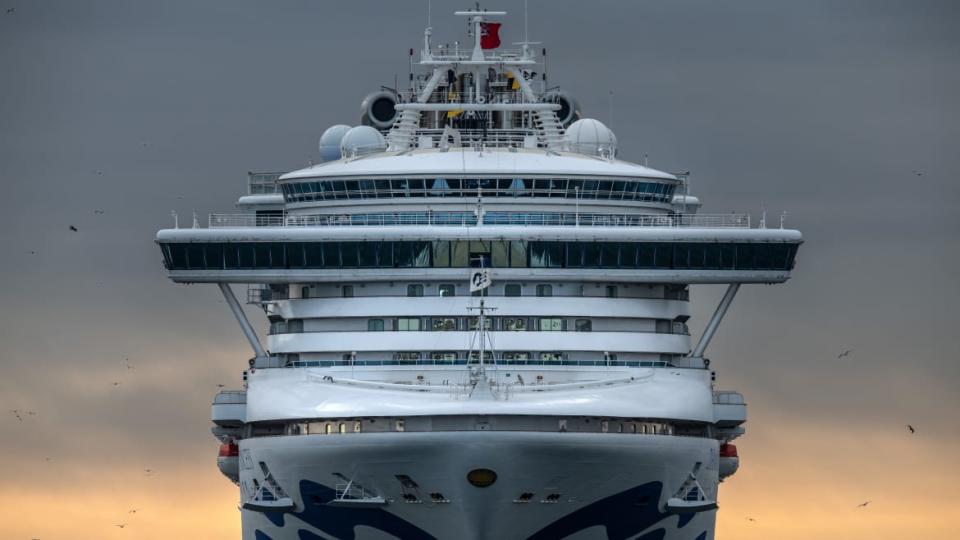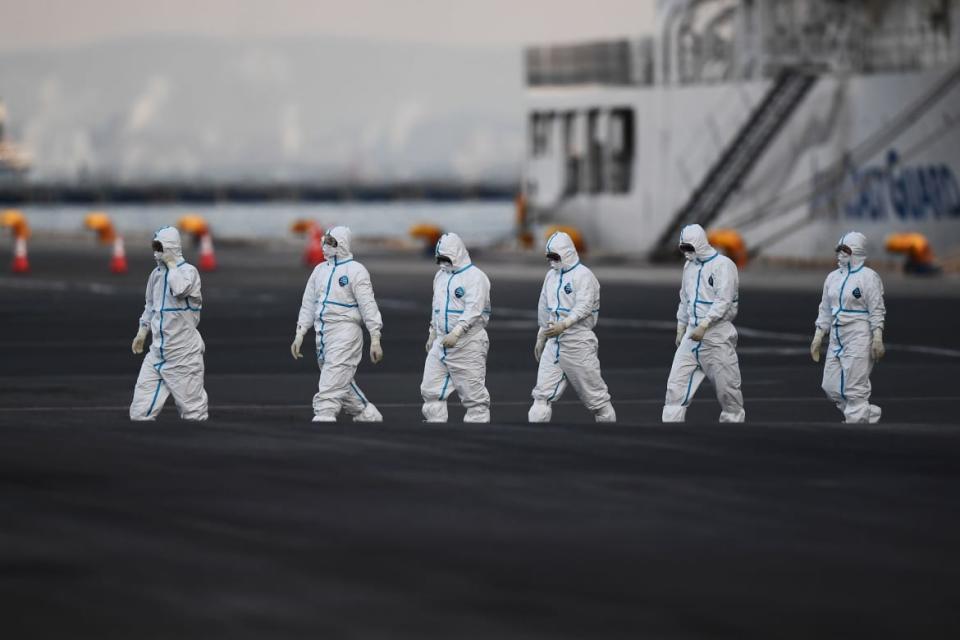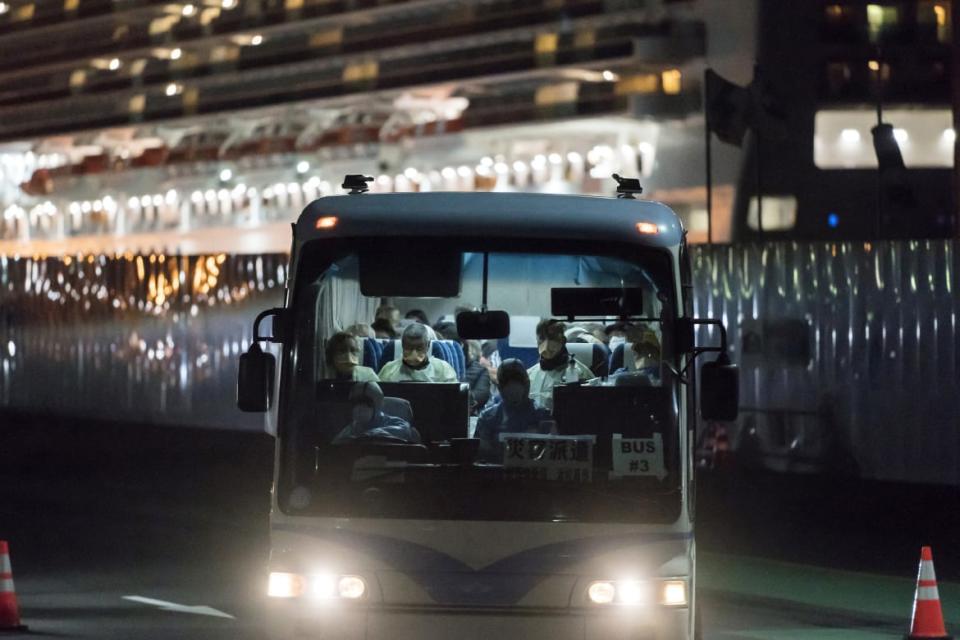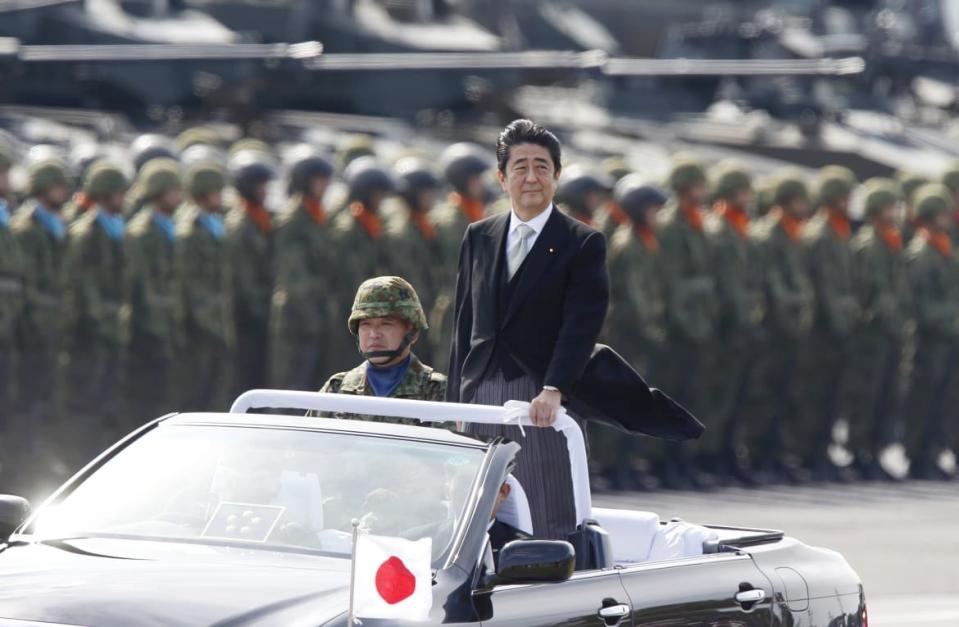Japan Shows Coronavirus May Be a Gift—for Would-Be Dictators

TOKYO—Early in the coronavirus crisis, a senior lawmaker from Japan’s ruling Liberal Democratic Party made a speech referring to the mysterious, frightening, and fast-spreading disease. “Maybe we should think of it as a great experiment,” he said.
But his thinking was not epidemiological—it was purely political, and in some ways as frightening as the sickness since named COVID-19.
Coronavirus Explodes in Italy, Threatening Europe. Can It Be Contained?
The politician was telling the party faithful that this might be the chance to realize their long-standing dream: the addition of a new clause to Japan’s post-World War II constitution that would let the prime minister rule with an iron fist in an emergency. The looming coronavirus outbreak could be such an occasion, he argued.
Think about it. The highly repressive Chinese Communist Party, after arresting and intimidating whistleblowers early in the outbreak, has since won acclaim from the World Health Organization for imposing draconian quarantines on tens of millions of people. This weekend, South Korea went on high alert, preparing to take what may be similar measures. Italy—Italy!—has locked down 50,000 people, with more restrictions expected soon.
Short of war, it’s hard to imagine more unlimited license for autocracy than the kind of plague spreading around the world right now.
But let us keep our focus on Japan, where there are so many lessons to be learned about how this incipient pandemic can affect not only the physical health of a population, but the political health of a nation.
On Feb. 3 what has since become known as the world’s biggest floating Petri dish, the cruise ship Diamond Princess, arrived in the Japanese port of Yokohama with 3,700 people on board, many already infected by the virus. This was truly a floating experiment, and it had docked.
COVID-19 arrived in Japan before the cruise ship, but on the vessel it was flourishing like that greenish blue crud kids grow in biology class, only the medium wasn’t agar, it was people.
Comments by the Japanese government suggest one reason Japan kept the passengers on the ship is that the government feared the large number of people with the virus would be counted statistically as “those infected in Japan.” They felt that would be very bad PR for tourism and the upcoming Olympics.
But while such a policy may have kept Japan’s infection statistics down temporarily, the overall effect has been extremely negative as the depths of Japan’s incompetent handling of the crisis have come to light.
What can we learn from it? Quite a bit about the virus, about Japanese and other autocrats, and about how not to stop a pandemic.
It’s a long read, so if you’re still trapped on the cruise ship, or are in the office in Tokyo (or Seoul, or somewhere in Italy) working despite having a high fever, sit back and catch up.
Here are some of the lessons learned so far.
THE SECOND EPICENTER
Many epidemiologists have now pointed out that the cruise ship on the port of Yokohama is the second largest epicenter of the virus in the world, right after Wuhan. But since the cruise ship is not a country, it generally hasn’t been described that way.
As of Feb. 23, at least 691 passengers were infected, along with four Japanese government workers who had been on the ship. Those figures released by the Japanese government may not include all those who have been evacuated from the ship and later found to be infected—numbers that are increasing each day.
The virus was first reported in Japan on Jan. 16, when a man tested positive after his return from Wuhan. The Japanese government later repatriated citizens from Wuhan and seemed to be handling the situation reasonably well.
The Diamond Princess, on a cruise advertised as a chance to “step into history” and to “uncover the stories of Japan,” departed Yokohama on Jan. 20 and stopped in Hong Kong, Vietnam, Taiwan, and Okinawa before arrived back in Yokohama at the beginning of this month.
Prior to arrival, however, a passenger who had disembarked in Hong Kong was confirmed positive for the virus. The government of Hong Kong announced late in the evening of Feb. 1 that an 80-year-old former passenger was infected.
When the ship arrived back in Yokohama two days later, the Japanese government requested that the cruise ship stay at port in Yokohama with no passengers or crew disembarking. On Feb. 5, a lab-confirmed case of COVID-19 led to the quarantine of the ship for 14 days; passengers were requested to stay in their cabins.

The Daikoku Pier Cruise Terminal in Yokohama port has been a hub of activity.
During that quarantine, the Japanese government flip-flopped on how it would deal with the problem–and the number of infected aboard the ship kept growing rapidly. There were 10 confirmed cases by the end of the day on Feb. 5. On Feb. 7, 60 cases. By Feb. 10, the number had risen to 135 people.
Appalled by the worsening situation, the United States, Australia, Italy, and others began to evacuate passengers from the ship and fly them home to special hospitals for isolation and observation.
This did not go well for the Americans. As the planes to the U.S. were set to leave on Feb. 17, new test results showed that 14 passengers already were infected. The State Department had promised that no one harboring the disease would be allowed to board the planes but, with less than optimum protection, the planes departed nonetheless. Infection may have spread further on the flight.
Meanwhile, as Japan evacuates Japanese passengers from the ship, many analysts are concerned that they will hasten the spread of the virus into the population here at large.
How did this happen? The answer involves a mixture of hubris, incompetence, possibly wishful thinking, and crass indifference.
LESSONS LEARNED ON BOARD
The ship-side outbreak was a foreseeable man-made disaster.
Masahiro Kami, head of Japan’s Medical Governance Research Institute, in an interview with the weekly magazine Bunshun, called the spread of the virus on board “a completely man-made disaster.”
Kami said in a case like this, “getting the crew and passengers off the ship is the consensus of the world. Once infection spreads inside the ship, even if you get those who manifest symptoms off the ship, there will be others aboard the ship still incubating the virus, and it will continue to spread.” He noted that in Italy and Hong Kong, ships with possibly infected passengers dealt with that problem, at least, swiftly and effectively.
A cruise ship is a perfect incubator for the virus.
The Diamond Princess quarantine might have worked, or at least worked better, if basic epidemiological protocols had been followed.
Kentaro Iwata, professor of infectious diseases at Kobe University, was horrified by the complete chaos he saw on the ship when he visited, and he blew the whistle.
Iwata noted that there was no clear separation made between infection-free green zones and potentially contaminated red zones. He saw some people moving between the zones without protective gear. He said that when he compared that situation to his past experiences in the field, on balance he felt safer during an Ebola outbreak. The ship looked like a “Coronavirus Production Machine.”
Iwata, who has stressed the need for Japan to have its own Centers for Disease Control and Prevention (CDC) “with autonomy, authority, transparency, and independence,” says that the Japanese government’s tendency to decide things behind closed doors is not conducive to good scientific decision-making.
Coronavirus is highly contagious and the testing is often inconclusive.
It’s not yet clear all the ways that the novel coronavirus is transmitted but what is clear is that living in close quarters with people who have it is a recipe for infection. The virus can survive on surfaces and be transmitted by touch, coughing, or sneezing, and probably through fecal matter as well—meaning sanitation problems could certainly spread the disease.
One of the problems with the virus is that it has an incubation period of 14 days on average but that could be as long as 24 days. There is still no simple nasal swab test for it. While a positive test result is usually conclusive, a negative result doesn’t mean that someone is virus-free.
Hasty evacuation may result in virus dissemination.
Despite the risks that those diagnosed as disease-free actually are carriers, the Japanese government began evacuating Japanese passengers from the ship on Feb. 19 and to date has let 969 passengers disembark. The Centers for Disease Control and Prevention says the Japanese quarantine may not have been sufficient from the start. As a gesture of no-confidence, the U.S. is now issuing a travel advisory for visiting Japan.
In fact, the way the ship evacuation was carried out contradicts the Japanese government’s own guidelines. Its ministry of health warns that those possibly infected should avoid public transportation, yet it sent possibly infected passengers home via public transportation.
Epidemiologists and other experts inside and outside Japan are warning that many of those evacuated off the ship could be taking the virus with them.
All around the world, there are signs that the testing was faulty. It may be that Japan has not only opened Pandora’s Box, it has dismantled it. Eighteen Americans, six Australians, and one Israeli evacuated from the ship have now tested positive for the virus. More may follow.
Australia was quite prepared for this.
In an interview with Australia’s ABC News, federal Chief Medical Officer Brendan Murphy said his country had been prepared for positive coronavirus cases among those who initially tested negative.
“Given the continued evidence the infection was spreading on board the Diamond Princess in recent days,” said Murphy, “the development of these positive cases after returning to Australia was not unexpected, despite all of the health screening conducted before departure, during the flight, and on arrival at the facility.”
“We now feel very strongly,” Murphy said, “that our plan to quarantine those people, even though many of them felt that they’d had 14 days of proper quarantine on the boat, was completely justified.”
Indeed.

Australians evacuated on a government chartered bus.
How will Japan justify its decision not to do the same?
On Saturday, a Japanese woman in her sixties, who had been cleared to evacuate the boat with her husband Wednesday, tested positive for the virus. They left the ship after testing negative and used public transportation to make it home to Tochigi Prefecture. The woman is the first among the Japanese passengers who have returned home to become sick with coronavirus. She may not be the last.
Over the weekend, the Japanese government admitted that it had also failed to test 23 passengers, 19 Japanese and four foreigners, during the two-week quarantine period.
The virus really can be deadly.
On Thursday, Japan announced that two Japanese passengers who had contracted the virus aboard the ship had died. The details of their health conditions before becoming ill from the disease are sketchy, but even Japan’s timid media is suggesting that if they had been evacuated from the ship earlier, they might have survived. One of the deceased had a high fever for a week before she was taken to a hospital. On Sunday, the third fatality occurred, a Japanese man in his eighties.
The World Health Organization estimates that the fatality rate for coronavirus is about 2 percent and that, of course, it is more deadly for elderly males and people with respiratory illness. But the percentage depends on how you crunch the numbers. Some analysts believe the mortality rate could be considerably higher.
In any case, many experts now believe that smoking cigarettes makes it even more likely the disease will prove fatal and Japan is a nation of heavy smokers, like China, where 2,442 people have died thus far. If there was ever a good time to quit smoking, that time may be now.
The Liberal Democratic Party of Japan, which controls the parliament, seems to understand this well and will postpone its annual convention due to the virus. That makes sense when you consider that the majority of the party is made up of cranky old men who smoke a lot.
LESSONS LEARNED ABOUT JAPAN
Japan’s ruling party welcomes the virus?
In the midst of a crisis that should be commanding Prime Minister Shinzo Abe’s full attention, he and the LDP can’t stop talking about the need to replace Japan’s pacifist constitution with their own version of it. It will be a version unencumbered by pacifism, popular sovereignty, or guaranteed human rights.
The LDP in 2012 proposed an “emergency powers” clause that actually was modeled on the one in the Weimar Constitution that let Adolf Hitler take over Germany. The clause stipulates that in times of emergency, the prime minister and his cabinet can consolidate power, suspend and limit basic freedoms—like human rights—and rule as they see fit.
As mentioned above, the LDP’s Bunmei Ibuki argued early on that the spread of coronavirus-induced pneumonia is an example of an emergency that would best be dealt with by giving the cabinet absolute power and could be a “great experiment.” Two days later, LDP lawmaker and Abe bestie Hakubun Shimomura said, “Human rights are important, but the public welfare is also important. We should start discussions on constitutional revision in the parliament in order to handle the current situation.”
This blatant attempt to hijack the virus outbreak to rewrite the constitution was condemned by several publications, including the Mainichi newspaper and even conservative business magazine President. In an editorial, the magazine called the administration’s exploitation of the problem “unscrupulous.”
Unfortunately, that doesn’t mean it is a losing strategy.

Japanese Prime Minister Shinzo Abe.
The Japanese government is just as incompetent as ever.
Koichi Nakano, a professor of Japanese Politics at Sophia University in Tokyo, doesn’t rule out the possibility that the administration will try to take advantage of the situation. But he adds, “I don’t think that the Abe government is deliberately being incompetent in order to let the virus break out so that it can use the matter to revise the constitution. It seems to me that it is incompetent without trying.”
Do you remember the triple nuclear meltdown at Fukushima in March 2011? The Japanese government would probably prefer that you didn’t.
For months, Japan and Tokyo Electric Power Company denied that there had even been a meltdown at the TEPCO Fukushima Nuclear plant, until they couldn’t deny it anymore. The warning signs that the plant was susceptible to flooding, which would cause a meltdown, and that one reactor was so old that it couldn’t withstand an earthquake and a tsunami were all ignored until it was too late.
The decision to downplay the nuclear damage resulted in mistrust and panic.
Those who were here then are experiencing déja vu now. When the health ministry admitted Saturday that it had let 23 passengers off the Diamond Princess without putting them through mandated tests for the virus, the surprise was not so much the ineptitude as the official recognition of it.
Bureaucrats would rather save face than save lives.
Grant Newsham, a former diplomat who has worked extensively as a liaison between the U.S. Marines and Japan’s Self Defense Forces, sees part of the problem as the Japanese bureaucracy’s abhorrence of admitting failure.
“The Yokohama ship incident brings to mind the 3/11 [Fukushima] nuclear disaster. It absolutely paralyzed the government of Japan. Why? They had ‘crisis-management plans’ and even had some practice and experience. But the particular incident was something ‘different’—and they couldn’t respond. They also were afraid of inviting in foreign experts and probably even Japanese experts who weren’t part of the elite clique. On display this time is the complete horror of Japanese officials admitting they are wrong—or even appearing they don’t know what they are doing. The fear of embarrassment, that great Japanese motivator, is also a terrible shackle.”
Japan isn’t ready for the 2020 Olympics.
This summer, Japan is due to host the 2020 Olympics. It seems ill-prepared, at best, for predictable calamity.
The ministry of health didn’t have enough qualified staff to put out updates on the coronavirus problem in English or other foreign languages until it became a public embarrassment. They were barely able to deal with a few thousand foreigners on a cruise ship. What will they do when many tens of thousands come for the Games during Japan’s notoriously brutally hot summer?
Considering that the number of heat-stroke victims climbs every year in Tokyo, and how emergency services in 2019 were stretched to the limit, one should be worried already about how the Olympics will work out. There were 164 deaths from heat-stroke in central Tokyo alone in the summer of 2019. Imagine an outbreak of coronavirus on top of the usual sweltering heat-induced chaos.
Shinzo Abe hopes to halt an epidemic in less than 10 minutes a day.
Throughout the crisis, Prime Minister Abe has made a tremendous effort to show leadership, or at least make a show of showing leadership. He is the chief of Japan’s Coronavirus Task Force, which was set up on Jan. 30 (which was the same day Ibuki told the world this virus might be a great experiment). Every cabinet member is supposed to attend the meetings, of which there have been 12 so far.
Here’s the problem, one which Japan’s mainstream media is not reporting, but which the Cabinet Secretariat Public Affairs Office confirmed with The Daily Beast: Each meeting is only 10 to 15 minutes long.
Abe shows up and has his photo taken; he sometimes doesn’t even stay for the whole discussion. On Valentine’s Day, he was there for a total of eight minutes and then went to the Imperial Hotel, where he wined and dined the president of Nikkei, Japan’s leading business newspaper.
Nikkan Gendai, an evening paper, tracked Abe’s movements after each cursory task force meeting and published the results. His post-conference evenings provide a wonderful chart of gourmet restaurants in Tokyo.
Coronavirus Spread by a Second Coming ‘Cult’ Has Put South Korea on ‘Maximum Alert’
Japan’s rulers are indifferent to the fate of the peasants.
Prof. Nakano is not surprised at the slow, callous response of Japan’s current government. “The problem is that the prime minister and his colleagues in the government and in the LDP are genuinely and consistently uninterested in the plight of the people in general.”
Nakano suggests Abe also may be “receiving advice from his entourage not to get associated with crises in order not to be held responsible for them.”
As a practical matter, Abe appears to have shoved the COVID-19 problem onto the shoulders of Katsunobu Kato, the health minister, who has become a punching bag in the aftermath of each poor decision by the cabinet.
“In the absence of a strong political leadership, the bureaucrats do, or rather don’t do, their things,” says Nakano. “It’s all about risk management at the expense of the larger crisis.”
A ministry of health staffer, on condition of anonymity, talked to The Daily Beast about the low morale and confusion within the agency:
“Minister Kato is a politician with no special knowledge of infectious diseases and who clearly doesn’t want to take charge. He knows that he’s going to take the fall when things go wrong, but then he can simply resign. We are stuck here. Decisions have been made based on minimizing negative publicity rather than limiting infection. There’s no one really in charge.”
Although four health workers who boarded the ship are now infected, the ministry initially refused to test the other 90 employees who had worked on the vessel; it will now test 41 of them.

The Diamond Princess cruise ship docked at Daikoku Pier.
THE OMINOUS FUTURE
At this point in time, there are still roughly 1,000 people aboard the Diamond Princess, mostly crew members. But, sadly, even after everyone has left, this problem is not going away.
If you’ll forgive us, let’s talk about the problem in metaphorical terms, because that may be the only way to understand how dire things are looking here now.
The virus has just jumped from one ship, the Diamond Princess, to another larger ship, as it were, the island nation of Japan.
As you read this, we are on the verge of an epidemic here and headed toward disaster; figuratively speaking, the captain is asleep at the wheel. The sailors are inexperienced. The passengers are getting sick, and some have already died.
And the answer given by those running the show? They say what they need is more command and control, a better ability to lock things down, stronger laws to make people keep quiet.
They’ve already fixing their “great experiment” to show no matter how much they do wrong, they are always right.
Get our top stories in your inbox every day. Sign up now!
Daily Beast Membership: Beast Inside goes deeper on the stories that matter to you. Learn more.

